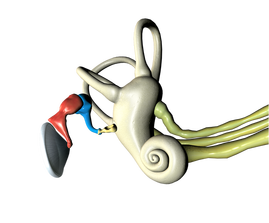How we hear

Hearing begins when sound is collected by the pinna and enters the outer ear. It travels through the ear canal. This wax producing passageway is lined with tiny hairs and small glands.
Next, the sound waves enter the middle ear, where the sound strikes the eardrum, which vibrates. Behind the eardrum are three tiny bones called the malleus, incus and stapes (also known as the hammer, anvil and stirrup). These bones transmit vibrations into the inner ear.
Next, the sound waves enter the middle ear, where the sound strikes the eardrum, which vibrates. Behind the eardrum are three tiny bones called the malleus, incus and stapes (also known as the hammer, anvil and stirrup). These bones transmit vibrations into the inner ear.
The main part of the inner ear is called the cochlea. The cochlea has about 25,000 to 30,0000 tiny nerve endings which convert sound waves into nerve impulses. The auditory nerve sends the impulses to the brain where they are interpreted as sound.
And walla, we hear!
The tiny nerve ending may damage over time and this causes sensorineural hearing loss. The more damage, the worse the hearing. If you believe your hearing has changed, it is important to have it checked. Please contact us for a free hearing test to find out what's happening.
And walla, we hear!
The tiny nerve ending may damage over time and this causes sensorineural hearing loss. The more damage, the worse the hearing. If you believe your hearing has changed, it is important to have it checked. Please contact us for a free hearing test to find out what's happening.
Our staff has helped thousands of south central PA hearing aid wearers hear better and we can help you too. We are committed to offering the best hearing aids in Lancaster County PA for the best price. We have been voted one of the best hearing aid businesses for the past several years because of this commitment. So please don't hesitate to call us for a no obligation hearing test.
